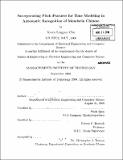| dc.contributor.advisor | Wade Shen and Robert C. Berwick. | en_US |
| dc.contributor.author | Chu, Karen Lingyun | en_US |
| dc.contributor.other | Massachusetts Institute of Technology. Dept. of Electrical Engineering and Computer Science. | en_US |
| dc.date.accessioned | 2011-02-23T14:41:11Z | |
| dc.date.available | 2011-02-23T14:41:11Z | |
| dc.date.copyright | 2009 | en_US |
| dc.date.issued | 2009 | en_US |
| dc.identifier.uri | http://hdl.handle.net/1721.1/61281 | |
| dc.description | Thesis (M. Eng.)--Massachusetts Institute of Technology, Dept. of Electrical Engineering and Computer Science, 2009. | en_US |
| dc.description | Cataloged from PDF version of thesis. | en_US |
| dc.description | Includes bibliographical references (p. 53-56). | en_US |
| dc.description.abstract | Tone plays a fundamental role in Mandarin Chinese, as it plays a lexical role in determining the meanings of words in spoken Mandarin. For example, these two sentences ... (I like horses) and ... (I like to scold) differ only in the tone carried by the last syllable. Thus, the inclusion of tone-related information through analysis of pitch data should improve the performance of automatic speech recognition (ASR) systems on Mandarin Chinese. The focus of this thesis is to improve the performance of a non-tonal automatic speech recognition (ASR) system on a Mandarin Chinese corpus by implementing modifications to the system code to incorporate pitch features. We compile and format a Mandarin Chinese broadcast new corpus for use with the ASR system, and implement a pitch feature extraction algorithm. Additionally, we investigate two algorithms for incorporating pitch features in Mandarin Chinese speech recognition. Firstly, we build and test a baseline tonal ASR system with embedded tone modeling by concatenating the cepstral and pitch feature vectors for use as the input to our phonetic model (a Hidden Markov Model, or HMM). We find that our embedded tone modeling algorithm does improve performance on Mandarin Chinese, showing that including tonal information is in fact contributive for Mandarin Chinese speech recognition. Secondly, we implement and test the effectiveness of HMM-based multistream models. | en_US |
| dc.description.statementofresponsibility | by Karen Lingyun Chu. | en_US |
| dc.format.extent | 56 p. | en_US |
| dc.language.iso | eng | en_US |
| dc.publisher | Massachusetts Institute of Technology | en_US |
| dc.rights | M.I.T. theses are protected by
copyright. They may be viewed from this source for any purpose, but
reproduction or distribution in any format is prohibited without written
permission. See provided URL for inquiries about permission. | en_US |
| dc.rights.uri | http://dspace.mit.edu/handle/1721.1/7582 | en_US |
| dc.subject | Electrical Engineering and Computer Science. | en_US |
| dc.title | Incorporating pitch features for tone modeling in automatic recognition of Mandarin Chinese | en_US |
| dc.type | Thesis | en_US |
| dc.description.degree | M.Eng. | en_US |
| dc.contributor.department | Massachusetts Institute of Technology. Department of Electrical Engineering and Computer Science | |
| dc.identifier.oclc | 702369091 | en_US |
